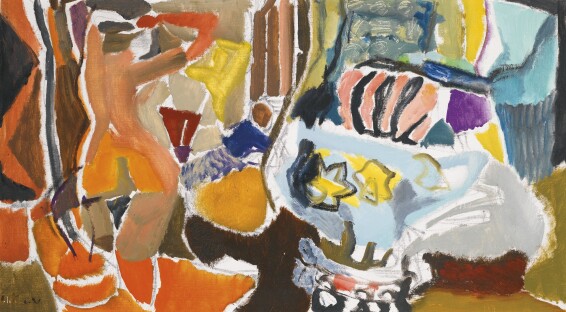- 26
Ivon Hitchens
Description
- Ivon Hitchens
- Interior Yellow Sunlight
- signed; further signed, titled, dated 1960 and inscribed on a label attached to the stretcher bar
- oil on canvas
- 51 by 92cm.; 20 by 36¼in.
Provenance
Condition
"In response to your inquiry, we are pleased to provide you with a general report of the condition of the property described above. Since we are not professional conservators or restorers, we urge you to consult with a restorer or conservator of your choice who will be better able to provide a detailed, professional report. Prospective buyers should inspect each lot to satisfy themselves as to condition and must understand that any statement made by Sotheby's is merely a subjective, qualified opinion. Prospective buyers should also refer to any Important Notices regarding this sale, which are printed in the Sale Catalogue.
NOTWITHSTANDING THIS REPORT OR ANY DISCUSSIONS CONCERNING A LOT, ALL LOTS ARE OFFERED AND SOLD AS IS" IN ACCORDANCE WITH THE CONDITIONS OF BUSINESS PRINTED IN THE SALE CATALOGUE."
Catalogue Note
After being bombed out of their home in London in 1940, Hitchens and his wife moved to Lavington Common, near Petworth in Sussex, where they had bought six acres of land the previous year, going on to build a studio at Lavington Common in 1941. This move was to form a turning point in Hitchens’ work: as Peter Khoroche notes, ‘it was as though the bomb-blast had freed him from former constraints, so that he could now follow his own path with certainty’ (Peter Khoroche, Ivon Hitchens, Lund Humphries, Aldershot, 2007, p.72). It is the interior of the studio there that most likely forms the subject of the present work.
The developments in Hitchens’ style whilst at Petworth are aptly illustrated through comparison of the present work with earlier paintings such as Interior, Boy in Bed, 1941 (Tate, London). In this work, and others from the period, Hitchens depicts his wife, Mollie, and their son John in the studio at Petworth, in a cosy domestic scene depicting typical family life. However, Interior Yellow Sunlight exudes a joyful vivacity and freedom of brushwork which demonstrates the increasing energy with which Hitchens approached the canvas. A wonderful shifting mosaic of colour, Interior Yellow Sunlight displays Hitchens’ personal pictorial language at its very best. There is an intricate and balanced play between figuration and abstraction, constructed with brushstrokes which carefully define, suggest and blend the scene into one which sings harmoniously.
Exerting his compositional powers to utmost effect, Hitchens presents an interior space in which the elements have been skilfully adapted to give an almost panoramic feeling to the canvas. Hitchens leads us through the work, encouraging our eye to move from left to right along the rectilinear canvas. Indeed, he commented on this desired fluidity, noting that: ‘I find a square-shaped painting usually unsatisfactory because the natural flow of the horizontals is checked’ (Ivon Hitchens, Notes on Painting, reproduced in ibid., p.80). The elements of the present work do indeed appear to ‘fall into place’ as Hitchens so desired, yet, as Causey perceptively notes, ‘the apparent ease of execution contributes to the general sense of relaxation but belies the firmness of the underlying structure’ (Andrew Causey, introduction to Ivon Hitchens: A Retrospective Exhibition, Royal Academy, London, 1979, p.15). Indeed, in the areas of white canvas left visible - serving both to succinctly outline elements of the composition, and lend a feeling of spontaneity - we can see traces of the artist’s underpainting, often done in blue acrylic paint, demonstrating the care with which Hitchens has composed the piece.
The warmth of the sunlit room adds to the feeling of exuberance: highly keyed tones recall the paintings of Matisse and the Fauves, yet, inkeeping with the Sussex setting of the studio, Hitchens modulates these with cooler tones as we move through the work and away from the figure, and there is almost the sense that elements of the surrounding landscape flow in from the far right corner. Hitchens wrote that ‘a good painter is he who, like a magician, having taken thought, utters the magic words and conjures up life from within the canvas’ (Ivon Hitchens, letter to Alan Bowness, 1956). In Interior Yellow Sunlight, we see Hitchens at his most magical: it is a jubilant work which tells of both painterly freedom and artistic control, as he leads the viewer through the work with deft, lyrical strokes.

